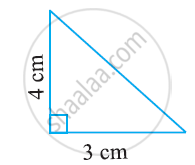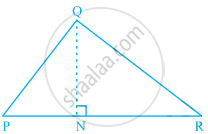Advertisements
Advertisements
प्रश्न
Show that the following points are collinear:
A(-5,1), B(5, 5) and C(10, 7)
उत्तर
`"Let " A(x_1=-5,y_1=1), B(x_2=5,y_2=5) and C(x_3= 10,y_3=7)`be the given points.
` Now , x_1(y_2-y_3)+x_2(y_3-y_1)+x_3(y_1-y_2)`
`=(-5)(5-7)+5(7-1)+10(1-5)`
`=-5(-2)+5(6)+10(-4)`
`=10+30-40`
= 0
Hence, the given points are collinear.
APPEARS IN
संबंधित प्रश्न
Find the area of the triangle formed by joining the mid-points of the sides of the triangle whose vertices are (0, -1), (2, 1) and (0, 3). Find the ratio of this area to the area of the given triangle
ABCD is a rectangle formed by the points A(-1, -1), B(-1, 4), C(5, 4) and D(5, -1). P, Q, R and S are the midpoints of AB, BC, CD and DA respectively. Is the quadrilateral PQRS a square? a rectangle? or a rhombus? Justify your answer.
Find the area of the following triangle:

Prove that (2, -2) (-2, 1) and (5, 2) are the vertices of a right-angled triangle. Find the area of the triangle and the length of the hypotenuse.
Find the area of ΔABC whose vertices are:
A(-5,7) , B (-4,-5) and C (4,5)
Find a relation between x and y, if the points A(2, 1), B(x, y) and C(7,5) are collinear.
In ∆PQR, PR = 8 cm, QR = 4 cm and PL = 5 cm. 
Find:
(i) the area of the ∆PQR
(ii) QM.
The base and the corresponding altitude of a parallelogram are 10 cm and 3.5 cm, respectively. The area of the parallelogram is 30 cm2.
Area of triangle PQR is 100 cm2 as shown in the below figure. If altitude QT is 10 cm, then its base PR is ______.

In the given figure, area of ΔPQR is 20 cm2 and area of ΔPQS is 44 cm2. Find the length RS, if PQ is perpendicular to QS and QR is 5 cm.

